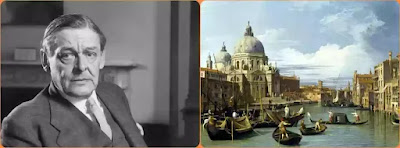Also Read
Burbank with A Baedeker: Bleistein with A Cigar
Tra-la-la-la-la-la-laire - nil nisi divinum stabile
est; caetera fumus--the gondola stopped, the old
palace was there, how charming its grey and pink - goats and monkeys, with such hair too! - so the
countess passed on until she came through the
little park, where Niobe presented her with a
cabinet, and so departed.
Burbank crossed a little bridge
Descending at a small hotel;
Princess Volupine arrived,
They were together, and he fell.
Defunctive music under sea
Passed seaward with the passing bell
Slowly: the God Hercules
Had left him, that had loved him well.
The horses, under the axletree
Beat up the dawn from Istria
With even feet. Her shuttered barge
Burned on the water all the day.
But this or such was Bleistein's way:
A saggy bending of the knees
And elbows, with the palms turned out,
Chicago Semite Viennese.
A lustreless protrusive eye
Stares from the protozoic slime
At a perspective of Canaletto.
The smoky candle end of time
Declines. On the Rialto once.
The rats are underneath the piles.
The jew is underneath the lot.
Money in furs. The boatman smiles,
Princess Volupine extends
A meagre, blue-nailed, phthisic hand
To climb the waterstair. Lights, lights,
She entertains Sir Ferdinand
Klein. Who clipped the lion's wings
And flea'd his rump and pared his claws?
Thought Burbank, meditating on
Time's ruins, and the seven laws.
Summary and Analysis
Introduction: The poem suggests a cartoon! It was published in the Poem 1920. It is one of the "Quatrain poems", known by that name for being written in a four-line stanza form, with the second and fourth lines rhyming. It has to be said, however, that the strict stanzaic form is not suitable for Eliot's fragmentary perceptions of experience for it seems to unite these experiences superficially.
Summary: The poem begins in a deceptively descriptive manner, but with the second stanza, the focus is shifted from the temporal to the spatial. From here onwards, Burbank, Princes Volupine, Bleistein, and Sir Ferdinand Klein became symbolic entities in a conflict of values rather than actors in a realistic drama. Burbank armed with a Baedeker, representing the creative arts, falls to infatuation and becomes aware of his impotence in modern Venice. Bleistein who provides a contrasting point of view, is not romantic, but commercial; his type is not localized (Chicago, Semite, Viennese), nor sensitive to local history. His eye has risen from the protozoic level to stare at a Canaletto, but it soon declines, like "the smoky candle end of time", for its interests are only commercial "On the Rialto once" recalls Shakespeare's Merchant of Venice and associated interests, but all this has been undermined by commercialism. Sir Ferdinand is the apex of the new commercialism signified by Bleistein. Princes Volupine, the name so suggestive of foxy craftiness and decayed sensuality symbolizes the degenerated aristocracy; once the aristocracy patronized the artists thus symbolizing the mating of commercial wealth with culture; now its representative extends a 'meager, blue-nailed phthisic hand' to a merchant price and not to the arts. Everything is controlled by money. The foundations of the past, the tradition and stability of the old world, have become saggy because of the new commercialism symbolized by the Jew - "The rats are underneath the piles."
On this decline of Venice Burbank speculates, wondering who clipped its lions (St. Mark's) making them cleaner but ineffective. His meditation on "Time's ruins, and the seven laws" involves Ruskin's principles of growth and decay which depend upon the morals of the age.
Critical Appreciation: An impression of Venice is conveyed through events in the poem. With utmost concentration and economy of language, but with great suggestive power, Eliot draws a continuous parallel between contemporaneity and antiquity. All the music of the past is definitive, and its ordered civilization is dying into a new barbarism. The pattern of oppositions serves to emphasize the ugliness, sterility, and decadence of the modern world. A mixture of direct sense impressions and references recalling works of art and associated interests combine to create the pattern. However, the density of exhibited learning in this poem seems unnecessary.
